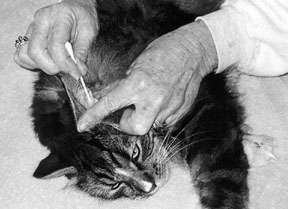
288
It cant hop and it cant fly, but it can walk. And if an ear mite – otherwise known as Otodectes cynotis – strolls into your cats ear, makes itself at home, and starts to raise a family, this minuscule parasite can cause major damage unless promptly evicted.
Ear mites are almost microscopically tiny – about the size of a very small pinhead, says William Miller Jr., VMD, a professor of dermatology at Cornell Universitys College of Veterinary Medicine. But, he notes, its sometimes possible to see their rapidly moving little bodies with the naked eye. They are also detectable by the general mess they make inside an infested animals ear canal – a dark, gooey, foul-smelling accumulation of wax and mite debris in which the spiderlike critter thrives.
Ear mites are extremely contagious, moving from one cat to another on close contact and eventually making their way to the ear. Infestation is most common among outdoor cats, whether theyre brawling or cozying up affectionately.
If the newly acquired mite is taking a cruise along the animals backside or belly, says Dr. Miller, the cat will groom it away with its tongue and swallow it. But the parasite is safe if it can make its way to the ear canal, where the animals paw or tongue cant get at it.
Signs of Infestation
Ear problems in general are uncommon among cats, Dr. Miller points out. But among these afflictions, ear-mite infestation is, by far, the most frequently diagnosed. The usual outward signs are clear: The outer ear is likely to be inflamed, and the animal will hold its ears flat against its head, scratch at them almost without letup, and shake its head frequently as if trying to dislodge a bothersome object. But the signs vary from cat to cat, Dr. Miller notes. There can be a lot of ear goo with no itching, he says, or there can be very little goo and a constant, rip-my-body-to-pieces kind of itching.
The Implications
If ear mite infestation is suspected, the cat owner should seek veterinary care without delay. Aside from relieving the animals discomfort, treatment can curb infection stemming from the mutilation of the ears and face that results from aggressive and nonstop scratching. Veterinary care can also prevent a serious ear disease called otitis externa – an infection of the outer ear that, if untreated, can progress to the middle and inner ear and damage the ear drum, which can permanently affect the animals hearing and balance.
A veterinarian can readily diagnose suspected ear mite infestation by using an otoscope, a flashlightlike instrument used to explore the depths of the ear. If the cat is unwilling to allow this instrument near its sensitive ears, the veterinarian will use a cotton swab to gently collect a sample of ear debris for conclusive microscopic examination. There are instances in which the mites are so few and far between that the veterinarian will have trouble confirming infestation, says Dr. Miller. The approach in that situation is to treat for mites anyway and see if the animal gets better.
Effective Treatments
Treatment begins with a thorough cleaning of the cats ears to remove any wax or debris that may shield the mites from topical medications. There are hundreds of topical, oral and systemic agents, Dr. Miller notes, and most – such as invermectin – are highly effective. Even one old-time remedy – baby oil – can do the job. A few drops put into an affected ear several times a day for a month or so will usually smother the mites.
Subsequent treatment for mites as well as ongoing maintenance of a cats ears, says Dr. Miller, can generally be done at home – as long as the owner has been given proper instruction by the veterinarian.
Precautions to Take
Since ear mites are transferred from one animal to another only through close physical contact, owners are advised to keep their cats indoors, away from neighborhood cats that might be carrying the parasite.
If you acquire a new cat, get it from a good breeder who will have made sure that the animal is free of mites. If you pick up a kitten off the street, from an animal shelter, or at a farm, you should have its ears checked for mites right away, says Dr. Miller. And if you have a multiple-cat household, keep the new kitten isolated from the others until you have its ears thoroughly examined.
In addition, Dr. Miller notes that several flea-control products are known to be effective in preventing ear mite infestation.



